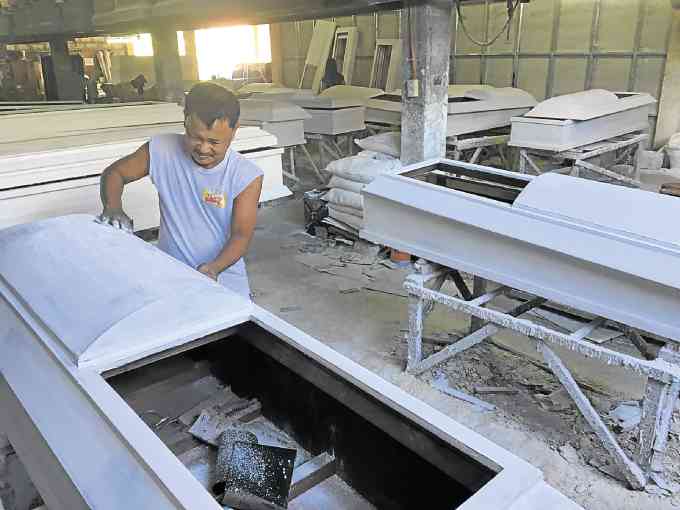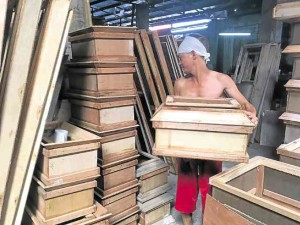
FINAL RESTING PLACE. Craftsmen in Sto. Tomas, Pampanga—hailed the Casket Capital of the Philippines—make coffins with lots of care and respect. Photos by Tonette Orejas
STO. TOMAS, PAMPANGA—Carpenters here know three sure facts: First is that death is inevitable. Second is that the casket industry thrives on death. And third is that they respect the dead by making quality coffins.
But this casket capital of the country, a recognition given by the Department of Trade and Industry (DTI) three decades back, is not a sunset industry.
To this day, there are about 100 registered enterprises and 200 backyard producers churning out beautiful caskets every month, says former Vice Mayor Marc Louie Arceo, who tried organizing the sector two years ago.
With an average output of 24,000 caskets a month, he said Sto. Tomas accounts for 70 percent of the market in the country.
The downside, however, is that the coffins are mostly sold through consignment, thus more capital is required to keep production going. Some makers unduly lower prices to shut off competition.
Resilience

Some have ventured out of Sto. Tomas in a form of diaspora that was observed even before the eruption of Mt. Pinatubo in 1991, and have carved their niche in faraway places, according to Caesar Lacson, who has written much about his hometown and its people.
Mario Nunag established a factory in Zamboanga City, supplying coffins up to Basilan. Alexander Canlas moved to Iloilo.
Leonora Zamora Gomez chose to relocate the business to Palawan, Boy Pingul to Arayat town in Pampanga, and former Mayor Romeo Pineda to Olongapo City and Zambales.
“They go where the competition is not stiff,” Arceo said.
To keep the business going, others have branched out to related enterprises. Arceo’s father, former Mayor Lucas Arceo, started making coffins in 1981, selling these as part of a package of funeral services in 1991.
Diversified
Years later, the elder Arceo diversified to funeral chapels and mortuaries. These ventures deviated from what Arceo’s
Florencio and his wife, Egmidia, formed the Paralaya Woodcraft in 1970 on a start-up capital of P500.
Editha Castro’s Triple K exports metal coffins to Australia, selling also metal sheets, chandeliers, carpets and hearses to funeral homes.
Some artisans have also secured jobs in large firms like Saint Peter Casket Manufacturing Co., which runs a factory in San Vicente and another in Barangay Sta. Rita in neighboring Minalin.
Concha Lapid and two of her sons managed to survive by keeping the business small, producing only 100 coffins a month and running a single funeral parlor.
The local government also promotes the industry through the Sabuaga Festival, which has been held every Easter Sunday since 2010.
It features the products of the villages: Pottery in Sto. Niño Sapa, agriculture in Sto. Rosario, fishery in Poblacion, garments in Moras dela Paz, caskets in San Vicente, stainless jeepneys in San Matias, and poultry in San Bartolome.
Honoring the dead
This is why coffin makers in Sto. Tomas can be relied on in times of disasters. They rush to make coffins for typhoon victims.
The industry must also survive for the jobs it generates.
Lacson said no out-of-school youth went hungry back in the 1970s because they sanded wood panels or gave painted surfaces a glossy finish.
A shop now employs a little over 20 workers, according to Arceo.
The industry, he said, is not threatened by China-made caskets, which are copies of those manufactured in the United States.
“Filipinos prefer locally made caskets,” he said. The going rate for a flat-top wood coffin is P3,000; metal, P16,000 to P35,000; stainless, P75,000; and bronze, P85,000.
“Coffins for babies, whom we consider angels, are given away, free,” Arceo said, adding that this is widely practiced in Sto. Tomas.
While they stay true to tradition, locals remain on the lookout for the latest trends to stay ahead of the game.
These days, for example, designs using lights and mosaics have gained popularity and the artisans have been quick to adapt.
Just the latest innovation in an industry that remains alive and kicking.

